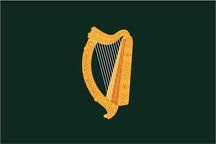St. Patrick Day Facts
"Not a wee bit of blarney here!"
March 17th is St. Patrick’s Feast Day, a day which commemorates his death in 461. As the Patron Saint of Ireland, the Irish have observed this day as a religious holiday since the 7thh century. Because it falls during the Christian season of Lent, eating meat, dancing, and drinking were forbidden, with the exception of this day! Irish families would traditionally attend church in the morning and celebrate in the afternoon. The main meal would have been Irish bacon & potatoes. The now traditional corned beef was born in American city's slums. For the poor Irish, meat was a rarity. But, a cheap piece of meat placed into brine gave it a better flavor and nicer texture. What could be a better way to celebrate the significance of St. Patrick’s Day!
Born Maewyn Succat in 387 to wealthy Roman parents in Britain, St. Patrick described in his spiritual memoir, “Confessio,” how at 16 years of age he was kidnapped and sold into slavery in Ireland. He escaped after 6 years, and rejoined his family, probably in present day Scotland. Afterward, a vision led him to study for the priesthood, where he took the name Patrick. During this time, he had a recurring dream whereby the “Voice of the Irish” called to him to return to Ireland to baptize and minister to them. He followed his dream with limited success, mostly attributed to his familiarity with the native customs. For example, he superimposed the powerful Irish sun symbol onto the cross, thus creating the Celtic Cross. From his own writings, we know that he did not convert all of Ireland to Christianity, nor does he mention using the shamrock to explain the Holy Trinity. As for banishing the nonexistent snakes from the island, this is believed a metaphor for driving paganism out of the land.
The "seamroy" was a sacred plant to the ancient Celts, who used it as a medical herb and as a symbol of spring. Over the centuries, this three-leaved clover came to represent St. Patrick, and after the British conquest of Ireland in 1603, the shamrock began to symbolize Irish nationalism. Because the British forbade the Irish to use their own language and practice Catholicism, wearing a shamrock became a symbol of pride in their heritage. It was during the unsuccessful 1798 uprising against British rule that "Going Green" also came to represent Ireland's separatism. The United Irishmen adopted the shamrock's green as part of their uniforms. However, it should be noted that St. Patrick's color is not green, but "St. Patrick Blue".
Old Gaelic society was based on an oral tradition. Chieftains in that time always included a bard and harper in their entourage. A harpist was so important that their finger nails were protected under ancient law. Not long after the 1185 Norman invasion of Ireland, the conquerors wrote that the Irish were lazy, uncivilized barbarians with one redeeming quality, their harping skills. Unlike the British, "the music is not slow and harsh, but lively and rapid, while the harmony is both sweet and gay". From then on, Ireland was associated with the harp. Since the 13th century, the harp has been the heraldic symbol of Ireland, originally on a background of blue, symbolizing the country's sovereignty. However, when the British unified Ireland, Scotland, and England, and stole the image, the defiant Irish changed the background to green. Today, the harp is still used to symbolize Ireland's identity. If Northern Ireland and Ireland reunite, some believe the Irish Harp Flag will replace the current flag.
What would St. Patrick's Day be without mentioning leprechauns. The sassy but kind caricature that we now envision has been attributed to Disney's 1959 movie, "Darby O'Gill and the Little People". Before Disney, these ancient Irish sprites were referred to as aged, diminutive, unfriendly, and gruff tricksters living alone in remote areas. Before the 20th century, they were depicted with a long beard and wearing red, not green. Their principal job as cobblers was to make shoes for the fae (members of the Irish Tuatha de Danann folklore). Being the most solitary of the fae, at times they are trusted to guard the fair folk's treasures, which they kept in crocks or pots. Some say it is their love of gold and miserly nature that really created the infamous "pots of gold". According to folklore, a rainbow or hammer sound alerts humans, whom the leprechauns greatly distrust, to where these treasures may lay. If one is lucky and captures a leprechaun, he will grant you three wishes, if you can get past his trickery.
Early Irish settlers, many of whom were indentured servants, brought the tradition of celebrating St. Patrick’s Feast Day to America. The first recorded St. Patrick's Day Parade in North American was held on March 17, 1601 in now St. Augustine, FL. It was directed by the Spanish colony's Irish vicar, Ricardo Artur. Homesick Irish soldiers serving in the English military marched in Boston in 1737, with the now famous NYC parade following in 1762. During the massive Irish migration in the 1840s and the anti-Irish sentiment that followed, St. Patrick’s Day celebrations became ways for the Irish to gain acceptance and melt into American culture.





